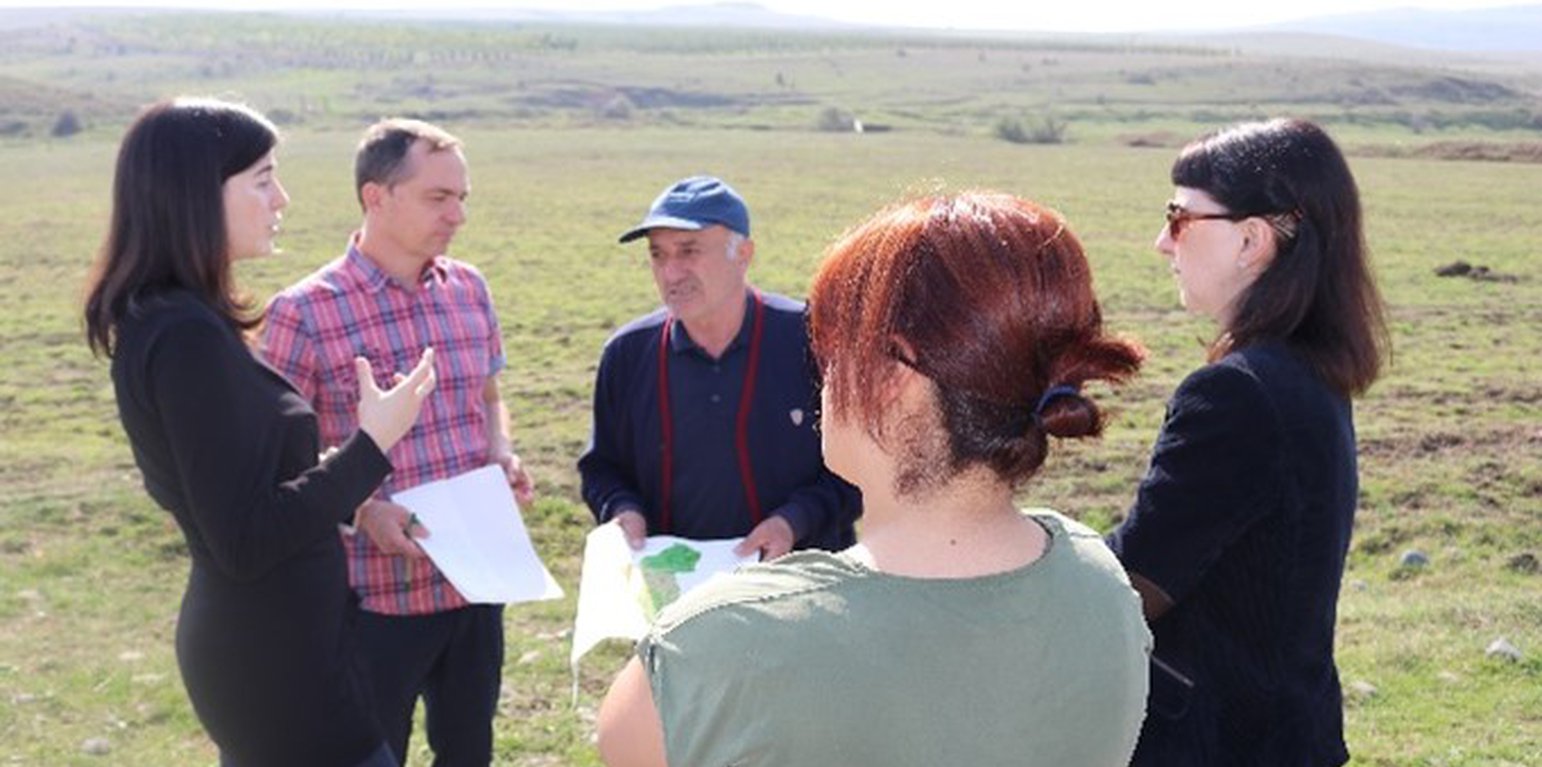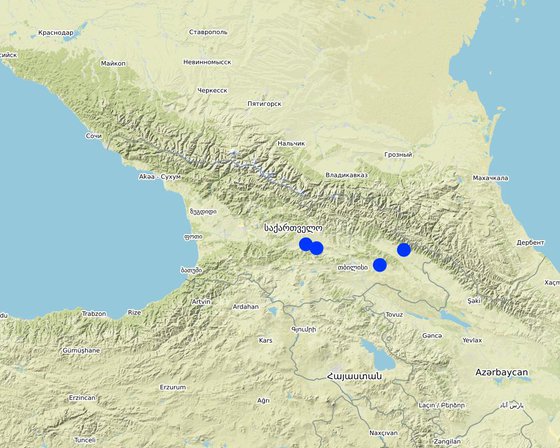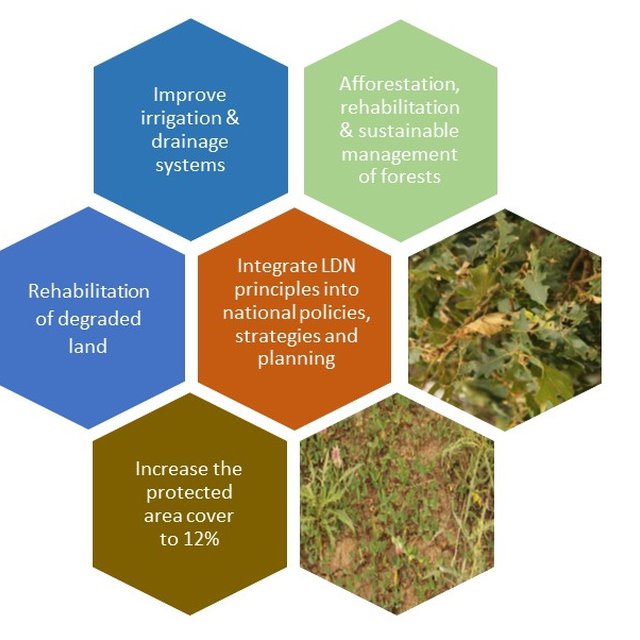



The three-year project ‘Generating Economic and Environmental Benefits from Sustainable Land Management for Vulnerable Rural Communities of Georgia' funded by the Global Environment Facility (GEF), is implemented by the United Nations Environment Programme (UNEP) and executed by the Regional Environmental Centre for the Caucasus (RECC). The initiator and beneficiary of the project is the Ministry of Environmental Protection and Agriculture of Georgia. Within this framework, Land Degradation Neutrality Transformative Projects and Programmes (LDN-TPP) were developed to implement the LDN targets at municipal level.
The project aims to create an enabling environment at the community level to achieve the country's goal of Gender Responsive Land Degradation Neutrality (LDN). The project supports local farmers to apply sustainable land management and climate-smart agricultural practices to promote food security and resilience in order to reduce the impacts of erosion, salinisation and soil fertility reduction in Sagarejo, Kvareli, Gori and Kareli on 20,000 ha of pilot land. As a result, it is expected that there will be an improved understanding of the economics of land degradation and integrated land use planning at national and sub-national levels. In the preceding approach recorded under WOCAT, namely ‘Integrated Land Use Plans (ILUPs) for sustainable agriculture and rural development with special emphasis on SLM, CSA and LDN in four municipalities [Georgia]’, ILUPs were developed for four municipalities providing a detailed spatial basis. A separate study (Ballesteros et al. 2020) compiled baseline information about LDN indicators.
This approach complements the ILUP. It combines the spatial information elaborated for land use planning, the LDN baseline information with national LDN targets, UNCCD principles for LDN and municipal stakeholder priorities to come up with a concrete plan for the municipal contribution to (inter)national targets. Thus, this approach serves to operationalise the national LDN targets at municipal level. At the time of documentation of this apporach, planning was completed and the participatory process for validation and decision-making for concrete targets had been initiated.
Taking this into account, a targeted programme was designed, which breaks down national targets into municipal targets with related activities and spatially explicit priority areas for implementation. This approach serves to operationalise LDN-related recommendations and proposed actions as presented and defined in the Integrated Land Use Plan. It seeks to define the contribution of the municipalities Gori, Kareli, Kvareli and Sagarejo to the achievement of national and global LDN targets.
The output is intended to serve as a starting point for local discussion (especially with the LDN Working Group) to further specify and prioritise the objectives and measures proposed. It provides a solid basis for discussing (a) concrete measures and (b) the areas best suited for these measures. The approach is documented in a consolidated document on how the municipality can contribute to the national LDN goals, based on the specific situation and potentials of the municipality.
The LDN TPP focuses on specific objectives and actions in the area of the municipality and its various functional land units in a pro-active, forward-looking and visionary manner as a contribution to the nationally set LDN objectives and the overall LDN vision. It presents possible and recommended development pathways and focuses predominantly on LDN implementation options through the application and adoption of various SLM and CSA practices.

ទីតាំង: Gori, Kareli, Kvareli and Sagarejo, Shida Kartlii and Kakheti, ប្រទេសហ្សកហ្ស៊ី
កាលបរិច្ឆេទចាប់ផ្តើម: 2019
ឆ្នាំបញ្ចប់: មិនមាន
ប្រភេទនៃវិធីសាស្ត្រផ្សព្វផ្សាយ
| តើមានភាគីពាក់ព័ន្ធ/ភ្នាក់ងារអនុវត្តន៍ណាខ្លះដែលបានចូលរួមក្នុងវិធីសាស្ត្រផ្សព្វផ្សាយ? | សូមបញ្ជាក់ភាគីពាក់ព័ន្ធ | សូមពណ៌នាតួនាទីរបស់ភាគីពាក់ព័ន្ធ |
| អ្នកប្រើប្រាស់ដីក្នុងតំបន់/សហគមន៍ | Various farmers | Visits to the fields with the local farmers, discussions about the type of cultivation |
| អ្នកស្រាវជ្រាវ | Tbilisi State University | Contribution of expert knowledge during meetings to interpret findings in a municipal context; provision of relevant scientific data; |
| អង្គការក្រៅរដ្ឋាភិបាល | REC Caucasus | Supervisors, consultants, GIS analyses, participation in the LDN Working Group Meeting |
| រដ្ឋាភិបាលថ្នាក់មូលដ្ឋាន | Executive Office of the Gori Municipal Council I Mayor’s City Hall (formerly Municipal Administration“Gamgeoba”), Municipality of Gori I Mayor’s City Hall (formerly Municipal Administration“Gamgeoba”), Municipality of Kareli I Mayor’s City Hall (formerly Municipal Administration“Gamgeoba”), Municipality of Kvareli I Mayor’s City Hall (formerly Municipal Administration“Gamgeoba”), Municipality of Sagarejo | Participation in the LDN Working Group Meeting |
| រដ្ឋាភិបាលថ្នាក់ជាតិ (អ្នករៀបចំផែនការ អ្នកសម្រេចចិត្ត) | Agricultural and Rural Development Agency (ARDA) Ministry of Environmental Protection and Agriculture of Georgia (MEPA) | Participation in the LDN Working Group Meeting |
ការសម្រេចចិត្តត្រូវបានធ្វើដោយ
ការសម្រេចចិត្តត្រូវបានធ្វើដោយផ្អែកលើ៖
The designed programme builds on 3 main elements: (1) local knowledge through project-based experiences and implicit knowledge of land users and the LDN group, (2) a spatial analysis of land use within the frame of the land-use planning process (see Zollner, 2021, separate approach recorded under Wocat) and (3) a LDN baseline study about the three global LDN indicators (land cover, net primary production and soil organic carbon) (Ballesteros et al. 2020).
It provides hard facts and spatial information about degradation, priority areas and potential measures for decision-makers
Not yet. As it is a plan.
It links the land-use planning process (and its results) with scientific information and translates it into actions - it builds on existing knowledge.
By linking local priorities with (inter)national obligations, it is expected that it will help to mobilise additional resources.
It provides solid condensed and local information to the Municipal LDN group
Close cooperation with international experts and local consultants increased the GIS-mapping capabilities of the national expert.
The municipal LDN group is a cross-institutional group of municipal stakeholders dealing with land degradation at municipal level.
This is expected to happen as together with land use planning it identifies priorities, challenges and needs.
Not yet, as these groups have not yet been involved - but will be involved (particularly land-users) who are the final beneficiaries of the measures.
It was not a major consideration. Work was only with the Municipal LDN group (which included women).
It was not a major consideration. Work was only with the Municipal LDN group
It addresses and highlights some of the pressing issues.
Not yet, but if implemented, it will make a major contribution.
Not yet, but if implemented, it will make a major contribution.
Not yet, but if implemented, it will make a significant contribution as water security , sustainable irrigation, and protection of water resources are key topics.
Not a priority.
Not yet, but if implemented, this is supposed to be one of the major contributions of the programme.
Not yet, but it seeks to enhance and secure incomes of farmers in the muncipality and outlines alternative income opportunities
The programme seeks agricultural transformation and a change in agricultural practice both reducing land degradation and increasing land productivity